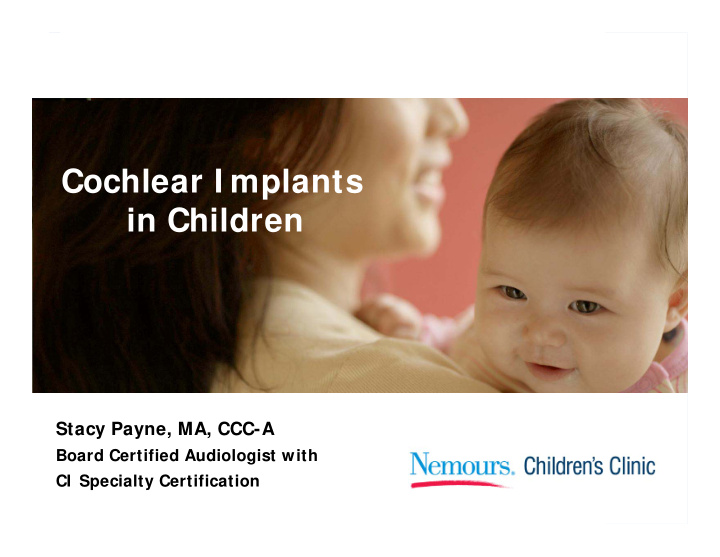



Cochlear I mplants in Children Stacy Payne, MA, CCC-A Board Certified Audiologist with CI Specialty Certification
Hearing Impairment There are 28 million hearing impaired individuals in the United States Severe to Profound Hearing Impairment affects 500,000 to 750,000 Americans 33 babies are born with some form of hearing loss every day, one third of these are profoundly deaf Source: Project HOPE, Policy Analysis Brief, April, 2000
Hearing Impairment 4500 infants are born each year profoundly deaf in the US (1/1000) 37,000 (6/1000) infants have significant hearing loss (> 55dB) 90% of children with congenital hearing loss have parents with normal hearing 60% genetic, 25% environmental, 15% unknown causes
Hearing Loss Types of Hearing Loss – Conductive – Sensorineural – Mixed – Neural
Hearing Loss Degrees of Hearing Loss – Mild – Moderate – Severe – Profound
Hearing Loss National Institutes of Health, the American Academy of Otolaryngology/Head and Neck Surgery, and the American Academy of Pediatrics have recommended that hearing loss in infants be identified, and when possible treated, prior to 6 months of age. Based on studies that have shown that children identified with hearing loss prior to 6 months of age have a better chance of developing skills equivalent to their peers by the time they enter kindergarten. Children not identified until later (children identified at age 2 to 3 years) may ultimately suffer from irreversible and permanent impairments in speech, language, and cognitive abilities when compared to their peers. From medicine.net.com
Hearing Loss •Infant hearing screening programs – now law in 36 states •Simple, quick, painless and reliable •Referral rate = ~ 2% •Once identified, quality treatment and devices can be available to babies to alleviate hearing loss –Medical and surgical interventions –Hearing aids and cochlear implants
Cochlear Implants
What is a cochlear implant? A cochlear implant is a “TOOL” for hearing For adults and children who receive little to no benefit from hearing aids For children, a cochlear implant on it’s own will not allow the child to develop normal speech and language Family support and therapeutic intervention are vital for allowing an implanted child to hear and talk
What is a cochlear implant? A prosthesis which is surgically implanted into the inner ear External equipment for sound processing Components – Receiver/stimulator internal device – Speech processor – Microphone – Transmitting coil – Cables – Batteries
Internal Device Receiver/ stimulator – Computer chip = “The Brain” – Receiving coil Electrode Array – Number of electrodes is dependent on device/processing strategy Magnet
External Devices Microphone Transmitting Coil Speech Processors – Converts acoustical signal into a “code” – “Code” is transmitted to internal device – Based on the code, the appropriate electrodes are stimulated to represent the acoustical signal
How it works…
Cochlear Advanced Bionics Cochlear Implants Med-El
“Which one is the “best” implant?”
Candidacy Criteria
Candidacy Criteria Pediatrics – Bilateral severe to profound sensorineural hearing loss – Appropriate amplification – No progress or plateau in therapy Progress notes from therapist No documented progress on questionnaires – Strong oral/auditory based communication is stressed – Highly motivated family with strong family support – No medical contraindications – Viable auditory nerve
Surgery
Surgery Uses common surgical techniques – “Seat” for receiver/stimulator – Mastoidectomy – Cochleostomy – Electrode Insertion General anesthesia Smaller incisions used for some cases Surgery usually less than 2 hours Minimal trauma and risks Facial nerve monitoring
Programming & Follow-up
Programming Routine follow-up is necessary to ensure proper functioning of cochlear implant Programming entails connecting speech processor to a computer and programming interface Current levels are adjusted based on each child’s individual needs Children are taught to make a conditioned response to sound to let programmer know if they hear
Therapy Auditory based intervention is the KEY to ensuring that an implanted child learns to hear and talk Use of sign language can inhibit the development of spoken language in implanted children Children should be enrolled in speech therapy/auditory training, auditory verbal therapy or oral education classroom
Outcomes Many factors affect outcomes of CI ’s in children – Age at implantation – Family support – Therapeutic and educational intervention – Communication methodology – Length of deafness – Age at identification – Etiology of hearing loss
Questions? Questions???? Visit us at Nemours.org
Recommend
More recommend